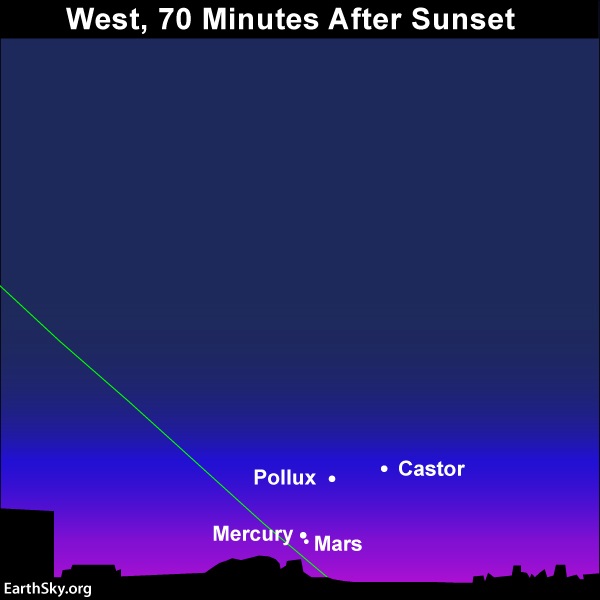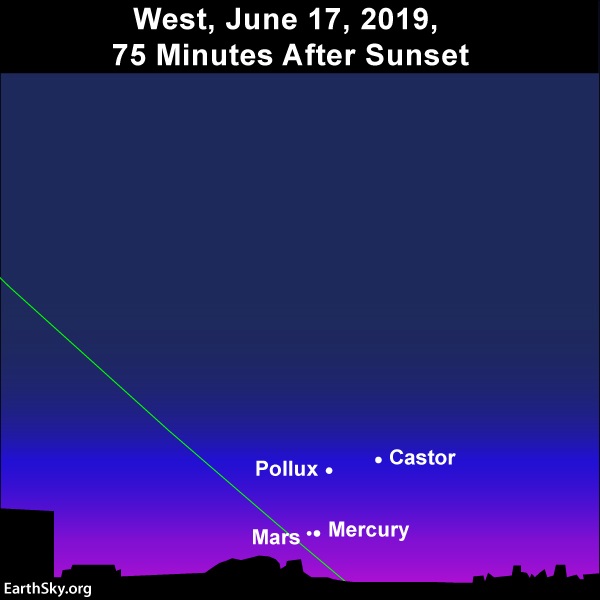

Look westward for the close pairing of the planets Mercury and Mars on June 18, 2019. You may need binoculars to glimpse fainter Mars next to brighter Mercury.
Mercury and Mars present the year’s closest conjunction of two planets, with Mercury passing a scant 0.2 degrees to the north of Mars on June 18, 2019. (For some perspective, 0.2 degrees is roughly equal to the width of a pencil at an arm’s length.) But don’t wait until June 18 to view these two close-knit worlds, which briefly adorn your western sky as dusk gives way to nightfall. Starting around June 10 or 11, look for Mercury and Mars to take stage within a single binocular field.
The charts below show the western evening sky on June 11, 2019, as viewed from mid-northern latitudes and temperate latitudes in the Southern Hemisphere.

The view of the western evening sky from mid-northern latitudes on June 11, 2019.

The view of Mercury and Mars as seen from temperate latitudes in the Southern Hemisphere on or near June 11, 2019.
Mercury is by far the brighter of these two worlds. Whereas Mercury may be visible to the eye alone some 60 to 75 minutes (or possibly sooner) after sunset, you’ll probably need binoculars to spot fainter Mars next to Mercury. On June 10, 2019, Mercury is over 6 times brighter than Mars. Thereafter, both Mercury and Mars dim throughout the month, yet Mercury dims much more rapidly than Mar does.
Click here for a sky almanac, giving you the setting times for the sun, Mercury and Mars in your sky.
The charts below show the positions of Mercury and Mars for mid-northern North America for June 16, 17 and 18, 2019. But no matter where you live worldwide, these two worlds will easily fit within a single binocular field. You may need binoculars to see Mars – or possibly both Mercury and Mars.

Mercury and Mars on June 16, 2019. Mercury is actually brighter than the star Regulus, but Regulus will be easier to see because it stays later after nightfall.

As seen from North America, Mercury and Mars stand side by side after sunset June 17, 2019.

Look westward for the close pairing of the planets Mercury and Mars on June 18, 2019. You may need binoculars to glimpse fainter Mars next to brighter Mercury.
On their conjunction date – June 18, 2019 – Mercury outshines Mars by about 4 times; by the month’s end, Mercury shines twice as brilliantly as the red planet. Although these planets remain fairly close together on the sky’s dome till the month’s end, it’ll be easier to spot Mercury and Mars earlier in the month than later on.
Bird’s-eye view of the north side of the inner solar system – Mercury, Venus, Earth and Mars – on June 18, 2019. People sometimes ask how a planet orbiting the sun inside of Earth’s orbit (such as Mercury) can ever be in conjunction with a planet orbiting the sun outside Earth’s orbit (such as Mars). Looking at the diagram, you can see that the Earth, Mercury and Mars make a straight line in space. Image via Solar System Live.
At their conjunction date on June 18, 2019, Mercury and Mars reside on nearly the same line of sight, but are not truly close together in space. At that time, Mars, the 4th planet outward from the sun, resides some 2.8 times farther from Earth than does Mercury, the solar system’s innermost planet.
Be sure to circle June 17, 18 and 19, 2019, on your calendar because that’s when these two planets snuggle up especially close together on the sky’s dome.
from EarthSky http://bit.ly/2R5pa0u


Look westward for the close pairing of the planets Mercury and Mars on June 18, 2019. You may need binoculars to glimpse fainter Mars next to brighter Mercury.
Mercury and Mars present the year’s closest conjunction of two planets, with Mercury passing a scant 0.2 degrees to the north of Mars on June 18, 2019. (For some perspective, 0.2 degrees is roughly equal to the width of a pencil at an arm’s length.) But don’t wait until June 18 to view these two close-knit worlds, which briefly adorn your western sky as dusk gives way to nightfall. Starting around June 10 or 11, look for Mercury and Mars to take stage within a single binocular field.
The charts below show the western evening sky on June 11, 2019, as viewed from mid-northern latitudes and temperate latitudes in the Southern Hemisphere.

The view of the western evening sky from mid-northern latitudes on June 11, 2019.

The view of Mercury and Mars as seen from temperate latitudes in the Southern Hemisphere on or near June 11, 2019.
Mercury is by far the brighter of these two worlds. Whereas Mercury may be visible to the eye alone some 60 to 75 minutes (or possibly sooner) after sunset, you’ll probably need binoculars to spot fainter Mars next to Mercury. On June 10, 2019, Mercury is over 6 times brighter than Mars. Thereafter, both Mercury and Mars dim throughout the month, yet Mercury dims much more rapidly than Mar does.
Click here for a sky almanac, giving you the setting times for the sun, Mercury and Mars in your sky.
The charts below show the positions of Mercury and Mars for mid-northern North America for June 16, 17 and 18, 2019. But no matter where you live worldwide, these two worlds will easily fit within a single binocular field. You may need binoculars to see Mars – or possibly both Mercury and Mars.

Mercury and Mars on June 16, 2019. Mercury is actually brighter than the star Regulus, but Regulus will be easier to see because it stays later after nightfall.

As seen from North America, Mercury and Mars stand side by side after sunset June 17, 2019.

Look westward for the close pairing of the planets Mercury and Mars on June 18, 2019. You may need binoculars to glimpse fainter Mars next to brighter Mercury.
On their conjunction date – June 18, 2019 – Mercury outshines Mars by about 4 times; by the month’s end, Mercury shines twice as brilliantly as the red planet. Although these planets remain fairly close together on the sky’s dome till the month’s end, it’ll be easier to spot Mercury and Mars earlier in the month than later on.
Bird’s-eye view of the north side of the inner solar system – Mercury, Venus, Earth and Mars – on June 18, 2019. People sometimes ask how a planet orbiting the sun inside of Earth’s orbit (such as Mercury) can ever be in conjunction with a planet orbiting the sun outside Earth’s orbit (such as Mars). Looking at the diagram, you can see that the Earth, Mercury and Mars make a straight line in space. Image via Solar System Live.
At their conjunction date on June 18, 2019, Mercury and Mars reside on nearly the same line of sight, but are not truly close together in space. At that time, Mars, the 4th planet outward from the sun, resides some 2.8 times farther from Earth than does Mercury, the solar system’s innermost planet.
Be sure to circle June 17, 18 and 19, 2019, on your calendar because that’s when these two planets snuggle up especially close together on the sky’s dome.
from EarthSky http://bit.ly/2R5pa0u

Aucun commentaire:
Enregistrer un commentaire